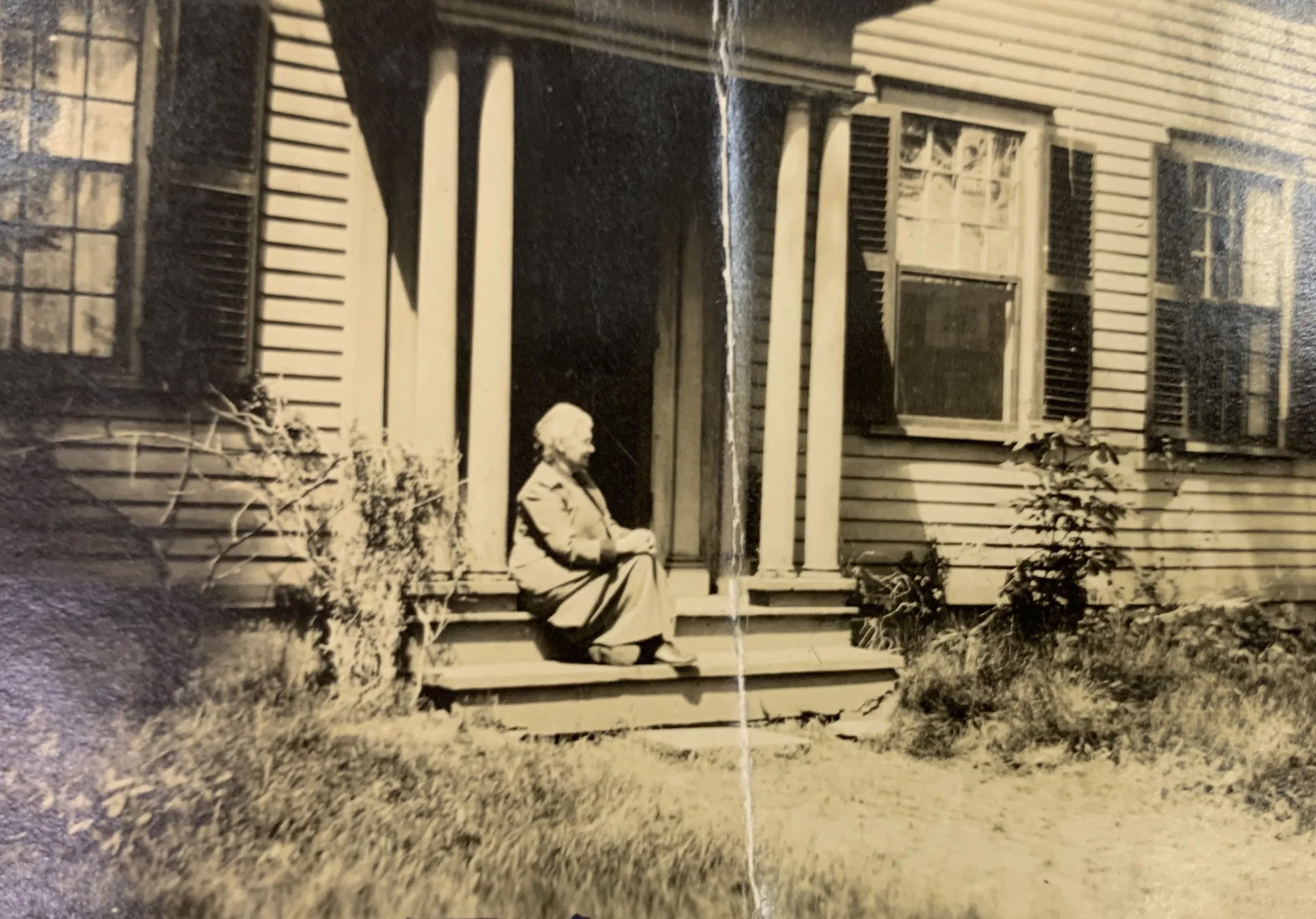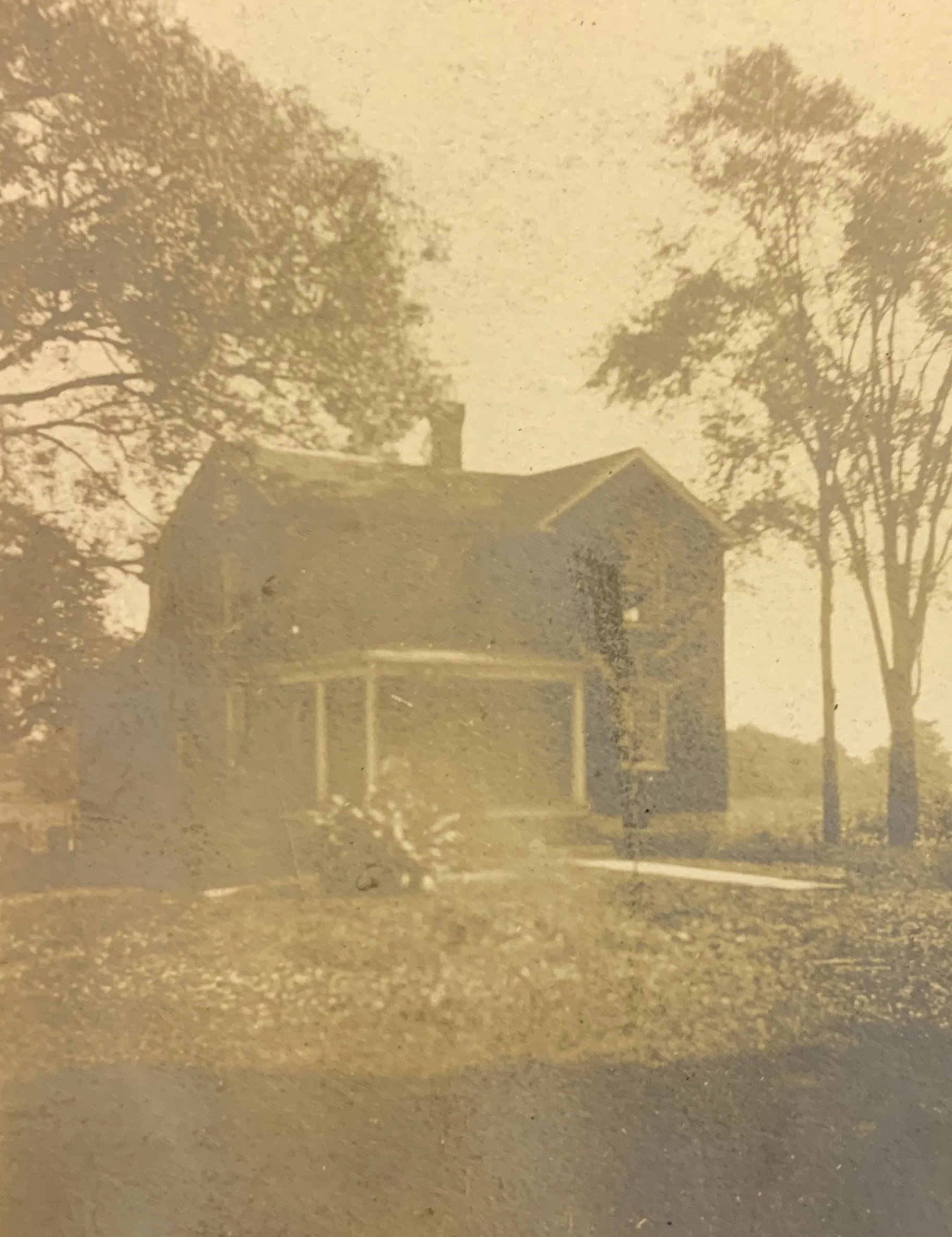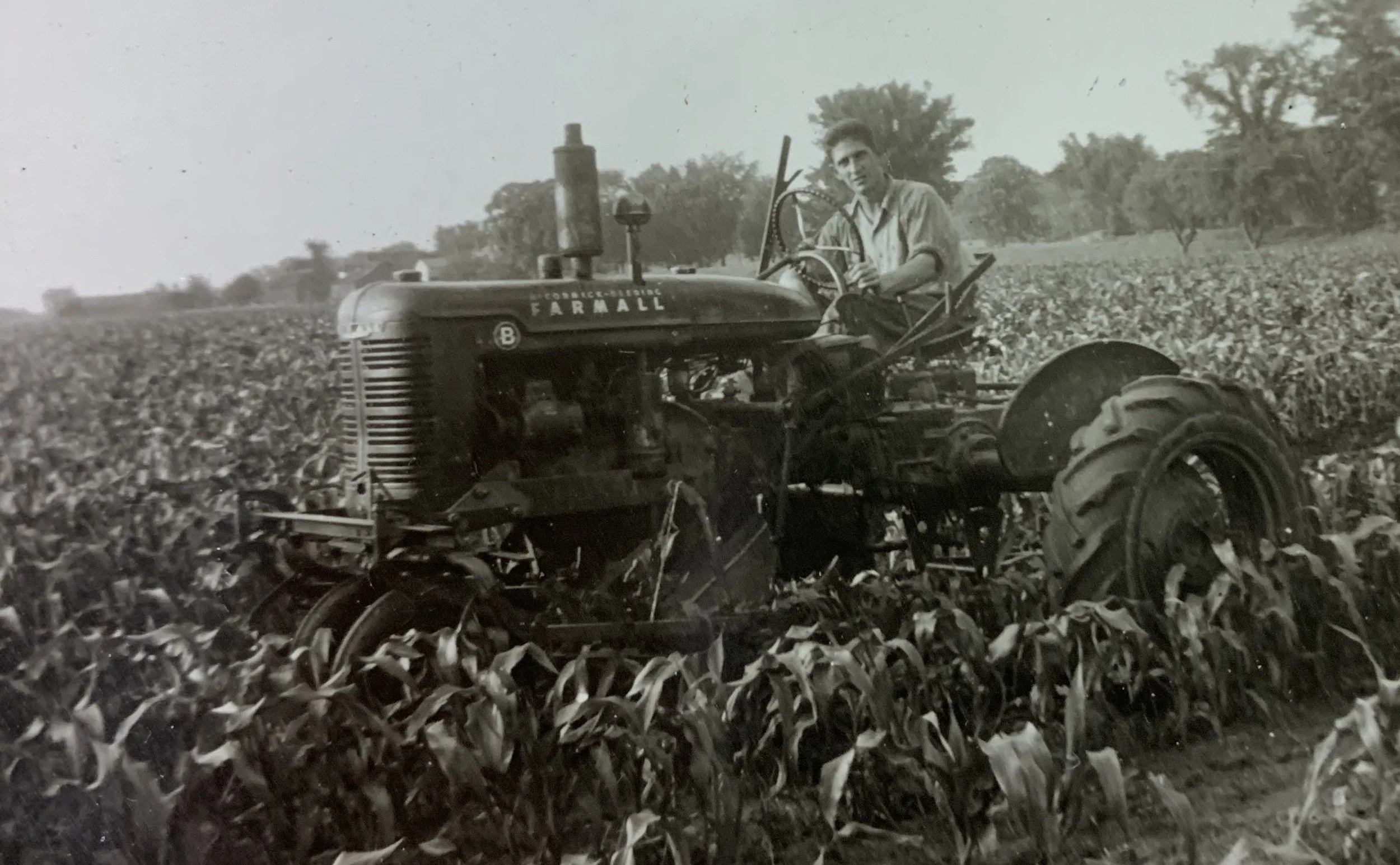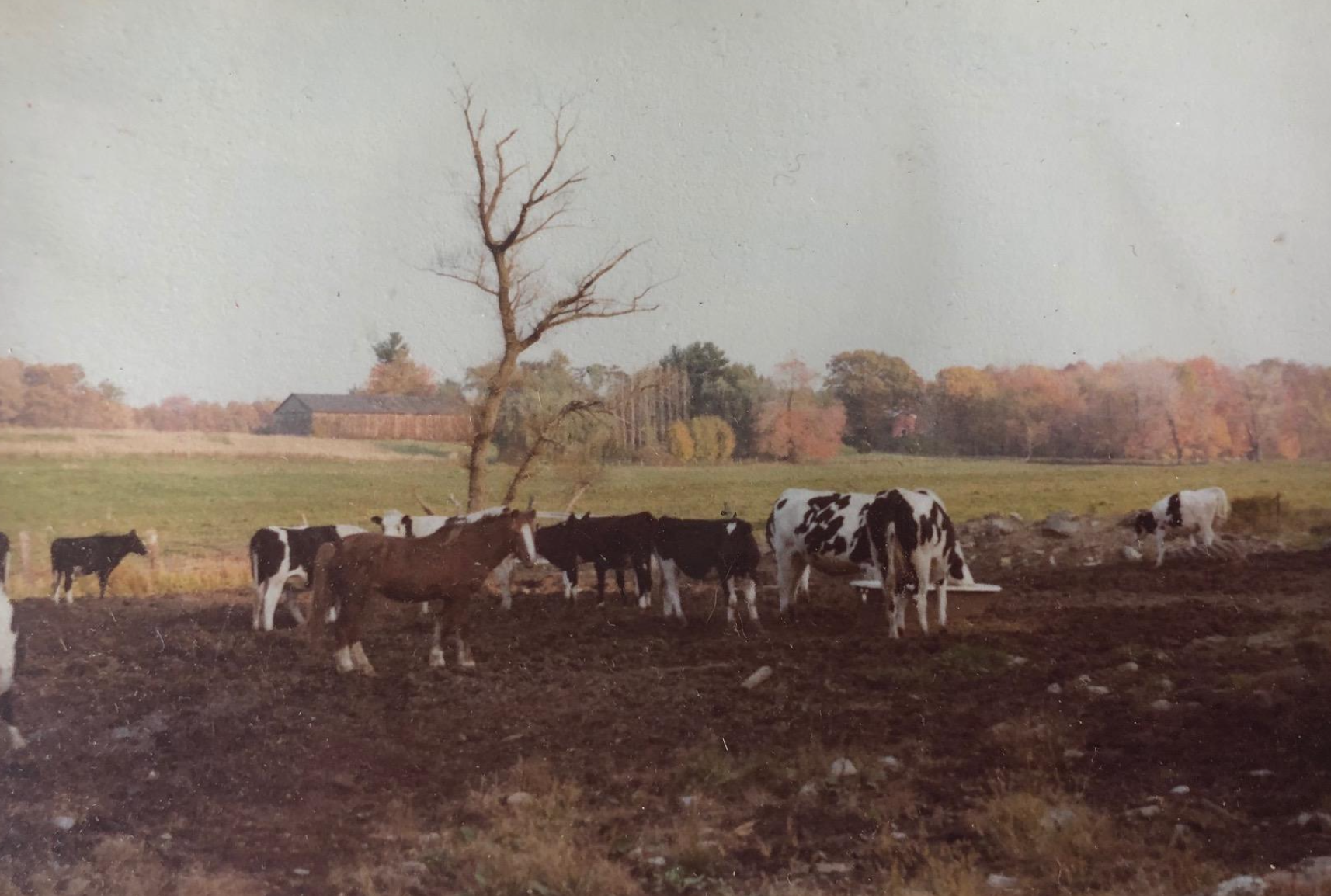Phelps Farm: Affluence and Influence at Pine Grove, 1815-1893 | Phelps Farm and the Dairy Industry, 1893-1978
Phelps Farm and the Dairy Industry, 1893-1978
Ruth Huntington Sessions sitting on the front porch of Phelps Farm, circa 1910. Source: Unprocessed collections of (Moses) Charles Porter Phelps, Special Collections and University Archives, University of Massachusetts Amherst.
The end of the Phelps line made Phelps Farm available to the Huntington family; its acquisition by Frederic Dan Huntington from Ellen Bullfinch in 1893 as a summer house for his daughter Ruth Huntington Sessions reconnected the property to the ancestral home at Forty Acres and inaugurated a new period in the farm’s land stewardship practices. Ruth—and later her son, John, and daughter-in-law, Doheny—transformed Phelps Farm into a thriving commercial dairy operation that persisted until 1978. In this period, it was largely the work of women like Ruth and later Doheny that propelled Phelps Farm as a leader in the local and statewide dairy community. These changes dramatically altered the natural and built landscapes at Phelps Farm as crop fields found new life as meadows for grazing cattle and the production of hay and silage to feed livestock. Still, traditional agriculture persisted at Phelps Farm to support the Sessions family’s dairy business.
Architect Frank L. Huxley designed this small manager’s cottage for Ruth Huntington Sessions in 1912 as a residence for a full-time farm manager as the scale of dairy production increased at Phelps Farm. Source: Unprocessed collections of (Moses) Charles Porter Phelps, Special Collections and University Archives, University of Massachusetts Amherst.
Frederic Dan Huntington conceived of Phelps Farm—then still known as Pine Grove—as a summer home for his daughter, Ruth, and her husband, Archibald Lowery Sessions, when he purchased it in 1893. At the same time, Ruth’s mother, Hannah Dane Sargent Huntington, had purchased a house for Ruth on Elm Street in Northampton that Ruth operated for many years as a dormitory for Smith College. Later known as Sessions House, Ruth hoped the dormitory would help Phelps Farm “earn its way” by supplying residents with chickens, fresh milk, and cream from the farm. Phelps Farm’s initial dairy herd, Ruth recalled, was “five good cows” and an “accredited Jersey herd.” Though a comparatively small breed, Jersey milk was increasingly understood to have about 20 percent more butterfat, as well as greater nutritional value. Ruth’s timing and selection of Jersey cows was prescient: by the turn of the twentieth century, thanks to developments in pasteurization and homogenization, the dairy sector was the most important in Massachusetts’ agricultural economy, positioning Phelps Farm to benefit from these scientific advancements. By 1914, Massachusetts legislators passed stricter controls on milk production as Ruth increased the scale of dairy production at Phelps Farm. During this period, Ruth “made over the old barn, adapting it to a larger herd” and in 1912 hired Northampton architect Frank L. Huxley to design a small cottage for a full-time farm manager to oversee the growing dairy herd. In 1913, Ruth instituted a milk route and continued to supply milk to Sessions House until she sold the dormitory to Smith College in 1922.
John and Doheny Sessions stand outside their home north of Phelps Farm with their daughter Jane Ann shortly after relocating from New York, circa 1930. Source: Unprocessed collections of (Moses) Charles Porter Phelps, Special Collections and University Archives, University of Massachusetts Amherst.
Robert Pierce riding a tractor in the corn fields near Phelps Farm, 1944. Source: Unprocessed collections of (Moses) Charles Porter Phelps, Special Collections and University Archives, University of Massachusetts Amherst.
Ruth convinced her son, John Archibald Sessions, to leave his job in New York and take up dairy farming at Phelps Farm where he acquired the farm from his mother in 1925. John attended Harvard University and married Florence Mary Doheny Hackett (Doheny) on July 2, 1927 in Manhattan. In 1929, John and Doheny hired Amherst contractor F.O. Graves to build a small cottage as their permanent home just north of the large farmhouse and agricultural buildings of Phelps Farm. John and Doheny’s arrival at Phelps Farm signaled new changes in land stewardship practices and the administration of the dairy business. By 1930, the herd at Phelps Farm had grown from just five cows to 55 head, prompting the purchase of hay from Forty Acres across the street and ever-larger meadows for grazing and producing silage. John and Doheny renovated the large dairy barn, adding metal stanchions and an automated barn cleaner; erected a new milk house in 1926 where cows were milked and the milk was then aerated and chilled to 40 degrees, bottled, and placed in cases that would sit in ice until they reached their destination; and in time would add three silos to the property for the storage of hay gathered in the surrounding fields. Other agricultural buildings included a horse barn and hay barn. John assumed leadership roles in the local and statewide farming community, serving as president of the Hampshire County Dairyman’s Association and the Federated Dairy Associations of Massachusetts. Under John and Doheny’s leadership, Phelps Farm continued to embrace efforts to boost the safety, quality, and nutritional value of milk. Phelps Farm appeared on lists of “fluid milk companies licensed to produce metabolized vitamin D milk through the feeding of irradiated yeast to dairy cattle,” one of just two dozen in Massachusetts and only five in the Connecticut Valley. The process, developed and implemented in the 1930s, involved adding to the feed yeast in a powder form, activated by ultraviolet light; the result was milk that carried as much vitamin D as three teaspoons of cod liver oil. New farm labor accompanied the growing scale of the farm, principally from the Pierce family: Charles, his wife, Esther, and his brother, Robert. Robert became a longtime fixture at Phelps Farm when he married Doheny’s sister, Jane, and took up residence in the manager’s cottage as the full-time farm manager in 1949.
This “‘V’ for Vitamins” poster puts a patriotic spin on the Phelps Farm dairy herd shortly after U.S. entry into World War II, advertising the farm’s production of metabolized vitamin D milk, 1942. Source: Unprocessed collections of (Moses) Charles Porter Phelps, Special Collections and University Archives, University of Massachusetts Amherst.
Cows lay in the meadows behind the agricultural outbuilding complex at Phelps Farm, circa 1945. Source: Unprocessed collections of (Moses) Charles Porter Phelps, Special Collections and University Archives, University of Massachusetts Amherst.
Cows and horses in the meadows to the east of Phelps Farm, circa 1970. Source: Unprocessed collections of (Moses) Charles Porter Phelps, Special Collections and University Archives, University of Massachusetts Amherst.
Ruth Huntington Sessions died December 2, 1946, and her son John A. Sessions died in 1948, leaving Doheny at the head of the farm enterprise. Farming continued at Phelps Farm through the 1950s, 1960s, and 1970s, under the direction of Doheny and the Pierces and with additional labor provided by a range of local workers, including college students who lodged or worked at the farm, some while studying agriculture at the University of Massachusetts. Consolidation across the dairy industry led to changes in the size and land stewardship practices of the most competitive farms, which grew increasingly larger; by this era, Phelps Farm, still milking around 50 cows, was one of the smallest, rather than the largest, dairy farms in the community. New technologies like the introduction of hydraulics softened the labor demands for dairymen, while the growth of artificial insemination removed bulls from farms, making the work safer and reducing the need for specialized structures to house bulls. Emerging knowledge about feed and nutrition encouraged dairy farmers to shift from hay to corn, a development with implications for silos and the designated cropland surrounding Phelps Farm. Consolidation across the industry also changed patterns of milk distribution, as local processing facilities in Amherst, Northampton, Hadley, South Hadley, and other towns were purchased by increasingly larger companies. In Hadley, the number of dairy herds dropped through the mid-twentieth century, from 42 herds in 1940 to 36 in 1955 to 30 in 1960. As small-scale dairy farming declined in places like Hadley, Doheny decided to sell the dairy herd in 1978 to Devine Farm, marking the conclusion of the site’s history as a dairy farm. But farming continued at the site: in 1979 the Parsons family began renting Phelps Farm acreage to produce hay for their own extensive farm operation that continues today on Mill Valley Road.






